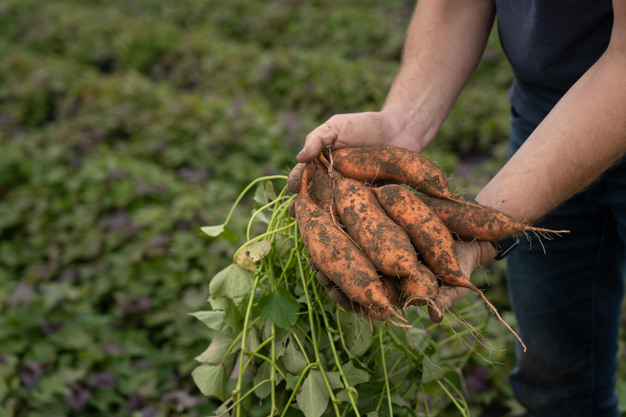Three years ago, Anne de Groot of the farm of the same name in Creil started growing sweet potatoes on about 200 hectares. "We started on a small scale with the cultivation of 1 hectare to see what possibilities this cultivation offers us. As a mainstream farm, there is a lot of pressure on the use of chemicals and fertilizer. The advantage is that with sweet potatoes you don't need much of that, which makes you a lot less vulnerable if crop protection products are dropped."

In the first year, De Groot focused mainly on the processing industry for sales. In the second year, he scaled up sweet potato cultivation to 5 hectares, divided into 2.5 hectares of the Covington variety for the fries market and 2.5 hectares of Bellevue for the fresh market. He also tested other varieties such as Radiance and Orleans on a small scale.

"The decline in Dutch sweet potatoes for the fries industry is limited, partly because last year a major Belgian processor stopped using Dutch sweet potatoes. We also had far too many last year for the industry and, more sweet potatoes ended up as mashed potatoes than as fries. For that reason, this year we are focusing on sales towards retail and have chosen to plant about 7 hectares of Bellevue and only 1 hectare of Covington/Beauregard for industry," Anne says.

Market not yet mature
"We saw last year that cultivation for the fresh market was successful and we were also able to organize sales towards Dutch supermarkets well," Anne says. "At the same time, the market for Dutch sweet potatoes is still developing. Buyers are still very unfamiliar with Dutch quality, even though it is very good. The samples I bring are therefore very much appreciated. I even have sweet potatoes from last year's harvest that I can sell just fine. But the market is still small and not quite mature. We see the domestic market as the main outlet for our sweet potatoes, supplemented by surrounding countries such as Belgium, Germany, and the UK."

"I am convinced that in time, say three or four years, we can move to year-round cultivation of sweet potatoes in the Netherlands. The question is whether this will succeed cost-wise because when the Egyptian supply breaks loose, the price difference is often too big. But qualitatively I do not foresee any obstacles," the sweet potato farmer continued. "The challenge for us as a grower is to be able to accommodate all quality standards and sizes. Demand from retail is very diverse. Some supermarkets want fine batches, while others prefer coarse batches. We see that the promotions at supermarkets are quite decisive for the volumes at sales."

Sharing knowledge and mechanization
"The number of growers in the Netherlands growing sweet potatoes is not that big. There are quite a few growers who tried it for a year but stopped again. We now have a club of about 15 growers who are serious about growing," Anne says. "Many of them are willing to share knowledge and mechanization. For example, fellow growers use our machines and I have our sweet potatoes washed by fellow growers again. Under the guidance of Delphy, we exchange a lot of information and the necessary research is also taking place in Belgium."

"All in all, we are still learning a lot together in the whole chain. Cultivation is still in its infancy. This year, for example, we could not get the Bellevue variety planted as early as we wanted because we only got the last planting material in at the beginning of June. Sweet potatoes must be out of the ground when the temperature goes below 10 degrees. Whereas normal potatoes can't tolerate frost, that's reached earlier with sweet potatoes, so you need to be lifting by early October at the latest," Anne says. "I think it's a very nice crop. Because of the covers on the ridge cultivation, apart from the planting holes, you hardly get any bother with weeds and the ridges warm up nicely."

Anne looks forward to the new season with confidence. "We are still looking for partners interested in locally grown, high-quality sweet potatoes. All our products are GlobalGAP and also Planet Proof-certified. Towards the fresh market, we are fully committed to Bellevue. That is a perfect variety for the consumer market with a nice shape and any damage does not immediately stand out on the product. But at the same time, we continue to grow many new varieties to arrive at the ultimate variety. Ideally, you want a variety with a nice shape that is also suitable for fries. That is difficult now with the Bellevue's lower dry matter content."

 For more information:
For more information:
Anne de Groot
The Bataat Farmer
Klutenpad 14
8312 PK Creil
Mob: 06-46266536
[email protected]
www.debataatboer.nl
